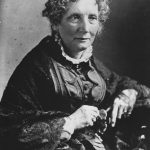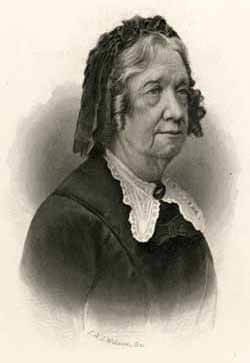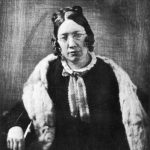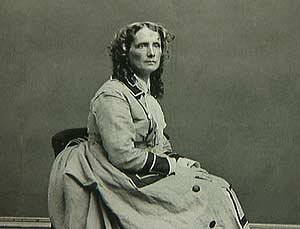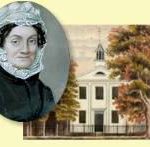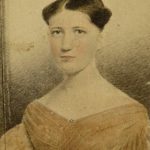American Abolitionist and Author
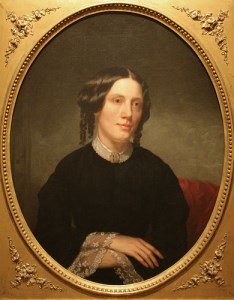 Harriet Beecher Stowe was an abolitionist and author. Her novel Uncle Tom’s Cabin (1852) was a depiction of life for African American slaves in the mid-nineteenth century, which energized anti-slavery forces in the North, while provoking widespread anger in the South. She wrote more than 20 books, and was influential both for her writings and her public stands on social issues of the day.
Harriet Beecher Stowe was an abolitionist and author. Her novel Uncle Tom’s Cabin (1852) was a depiction of life for African American slaves in the mid-nineteenth century, which energized anti-slavery forces in the North, while provoking widespread anger in the South. She wrote more than 20 books, and was influential both for her writings and her public stands on social issues of the day.
Harriet Elisabeth Beecher was born in Litchfield, Connecticut, on June 14, 1811. She was the second daughter the sixth of eleven children born to outspoken religious leader Lyman Beecher and Roxanna Foote Beecher, who died when Stowe was only four years old. Harriet’s oldest sister, Catherine Beecher, then took over care of the children.
The Beechers expected their children to shape their world: all seven sons became ministers, including Henry Ward Beecher; oldest daughter Catherine pioneered education for women; youngest daughter Isabella Beecher Hooker was a founder of the National Women’s Suffrage Association. Harriet believed her purpose in life was to write; at seven, she won a school essay contest earning praise from her father.
Lyman Beecher’s second wife, Harriet Porter, was a beautiful woman slightly overwhelmed by the eight boisterous children she inherited. Her own children, Isabella, Thomas and James, added to the noisy household.
Harriet Beecher began her formal education at Sarah Pierce‘s Litchfield Female Academy, one of the earliest to encourage girls to study academic subjects and not simply homemaking skills. In 1824, Harriet moved to Hartford, Connecticut, and became first a student and later an assistant teacher at Hartford Female Seminary, founded and run by her sister Catherine. It was a unique school, focusing on the importance of women’s education. There, Harriet developed her writing talents, spending hours composing essays.
In 1832, Harriet and Catherine moved to Cincinnati, Ohio, with their father, who had been appointed President of the Lane Theological Seminary. They lived in a house provided by the Seminary, and soon after settling in, Harriet and her sister established the Western Female Institute.
Harriet associated in literary circles with the likes of Salmon P. Chase (later governor, senator, member of Lincoln’s cabinet and Supreme Court chief justice) and Calvin Ellis Stowe, a Lane professor of biblical theology, whose wife Eliza became a close friend to Harriet. Eliza died in August 1834.
In 1833, while teaching at the Western Female Institute, the Beecher sisters published Geography for Children, Harriet’s first book. The following year Harriet won a prize for “New England Sketch,” published in the Western Monthly Magazine. Soon she was writing articles and stories for that publication and others, including The Atlantic Monthly, New York Evangelist, The Independent and The Christian Union.
During the 1830s, Harriet became an abolitionist. Cincinnati was across the Ohio River fom the state of Kentucky where slavery was legal. Thousands of runaway slaves passed through Cincinnati as they traveled to freedom, and Harriet met escaped slaves and heard stories of their appalling treatment.
There were race riots in Cincinnati in 1836, caused by racial tensions at a time when ex-slaves were competing with whites for jobs. The rioters attacked blacks and the whites who supported them. Buildings were burned and several blacks lost their lives.
Harriet described the Cincinnati Riots:
The mayor was a silent spectator of these proceedings, and was heard to say, ‘Well, lads, you have done well, so far; go home now before you disgrace yourselves;’ but the ‘lads’ spent the rest of the night and a greater part of the next day (Sunday) in pulling down the houses of inoffensive and respectable blacks.
The Gazette office was threatened, the Journal office was to go next; Lane Seminary and the water-works also were mentioned as probable points to be attacked by the mob. By Tuesday morning the city was pretty well alarmed. A regular corps of volunteers was organized, who for three nights patrolled the streets with firearms and with legal warrant from the mayor, who by this time was glad to give it, to put down the mob even by bloodshed.
During the 18 years she lived in Cincinnati, Harriet became friends with several Ohio abolitionists, including James G. Birney, Gamaliel Bailey, Theodore Dwight Weld and John Rankin, whose home in Ripley, Ohio, served as a stop on the Underground Railroad.
Marriage and Family
After her friend Eliza Stowe’s died in 1834, Harriet’s friendship with widower Calvin Stowe had deepened. In January 1836 she married Calvin Stowe, who was nine years older than she. They had seven children together, four of whom died in Harriet’s lifetime. Six of the children were born in Cincinnati.
Harriet began writing professionally, selling short stories and articles to popular magazines, using her earnings to pay for household help. In the summer of 1849, Samuel Charles Stowe, her 18-month old son died of cholera. Stowe later credited that crushing pain as an inspiration for Uncle Tom’s Cabin because it helped her understand the pain enslaved mothers felt when their children were taken from them to be sold.
Calvin Stowe was active in the public education system and often traveled for work. During one of his absences, Harriet wrote to her husband of many years, “If you were not already my dearly beloved husband, I should certainly fall in love with you.” Calvin was always supportive of Harriet’s literary career; she published The Mayflower, a collection of tales and sketches, in 1843.
In 1850 Calvin Stowe joined the faculty of his alma mater, Bowdoin College in Brunswick, Maine, and the family moved there, living in Brunswick until 1853. They then relocated to Andover, Massachusetts, where Calvin was a professor of theology at Andover Theological Seminary from 1853 to 1863.
Uncle Tom’s Cabin
In 1850 the U.S. government passed the Fugitive Slave Law, which punished those who aided runaway slaves, stripped the rights of the fugitives, and diminished the rights of free Blacks. Harriet objected to the federal government actively assisting slave owners in their efforts to reclaim their runaway slaves in the Northern states.
During a communion service at the college, Harriet had a vision of a dying slave, and she began writing a story about slavery, using the form of a novel to communicate the pain and suffering caused by slavery. She realized that most Northerners had no idea how devastating slavery could be, and wanted to educate the public about the brutalities of the institution.
Harriet researched the topic well, using her own experiences, enlisting friends and family to send her information and scouring freedom narratives and anti-slavery newspapers for first hand accounts as she composed her story. She asked prominent former slave Frederick Douglass to put her in touch with ex-slaves in order to ensure the accuracy of her story.
In 1851, The National Era‘s publisher Gamaliel Bailey contracted with Harriet Beecher Stowe for a story that would “paint a word picture of slavery” that would run in installments in the antislavery newspaper. She expected the story to be three or four installments; she wrote more than forty.
On June 5, 1851, The National Era began publishing installments of Uncle Tom’s Cabin. It was so popular that readers wrote to the newspaper begging for more, and the circulation of the paper doubled. New segments appeared in most weekly issues of the newspaper through April 1 of the following year.
The action of the story traces the passage of the slave Uncle Tom through the hands of three owners, each meant to represent a type of Southern figure. The first is a kind planter, the second a highbred gentleman, and the last the infamous Simon Legree, who causes the death of Uncle Tom. The fortunes of the slaves in the book curve downward, and the finally successful dash for freedom by George and Eliza constitutes the high drama of the story.
In 1852 the serial was published as a book entitled Uncle Tom’s Cabin or Life Among the Lowly. Its emotional portrayal of the impact of slavery captured the nation’s attention, and added to the debate about abolition and slavery. It was a bestseller in the United States, England, Europe, Asia, and was translated into more than 60 languages. Some sources estimate as many as 325,000 copies were sold in the first year.
The novel was dismissed by some as abolitionist propaganda; yet Leo Tolstoy deemed it a great work of literature “flowing from love of God and man.” Though Uncle Tom’s Cabin received great attention, its reception was often hostile. Not only in the South, but also in the North, there were charges that the world of the slave had been melodramatically misrepresented.
The novel was universally denounced in the South as a distortion, so Stowe published another book, A Key to Uncle Tom’s Cabin, documenting the actual cases on which her book was based, to refute critics who tried to argue that it was inauthentic.
Stowe was catapulted to international fame with the publication of Uncle Tom’s Cabin. A petition signed by half a million English, Scottish and Irish women, addressed to the women of the United States, led to a trip to Europe in 1853 for Harriet, Calvin and Harriet’s brother Charles Beecher. She turned her experiences on this trip into a book, Sunny Memories of Foreign Lands.
Frederick Douglass letter to Harriet Beecher Stowe:
March 8, 1853
You kindly informed me, when at your house, a fortnight ago, that you designed to do something which should permanently contribute to the improvement and elevation of the free colored people in the United States. You especially expressed an interest in such of this class as had become free by their own exertions, and desired most of all to be of service to them.
…I desire to express, dear Madam, my deep sense of the value of the services which you have already rendered my afflicted and persecuted people, by the publication of your inimitable book on the subject of slavery. That contribution to our bleeding cause, alone, involves us in a debt of gratitude which cannot be measured; and your resolution to make other exertions on our behalf excites in me emotions and sentiments, which I scarcely need try to give forth in words.
Suffice it to say, that I believe you to have the blessings of your enslaved countrymen and countrywomen; and the still higher reward which comes to the soul in the smiles of our merciful Heavenly father, whose ear is ever open to the cries of the oppressed…
In 1856 Stowe published Dred: A Tale from the Swamp, a more forceful antislavery novel. Its reception was hardly less enthusiastic than that of Uncle Tom’s Cabin. In England alone, during the first month, over 100,000 copies were sold.
Stowe returned to England in 1856, meeting Queen Victoria and befriending Lady Byron, the widow of the poet Lord Byron. Among others she met were Charles Dickens, Elizabeth Barrett Browning and George Eliot.
Her 1859 novel, The Minister’s Wooing, was set in the New England of her youth, and drew on her sadness in losing a second son – Henry Ellis Stowe drowned in an accident while a student at Dartmouth College. Harriet’s later writing focused mainly on New England settings.
By the late 1850s, Harriet Beecher Stowe was firmly established as a major American writer. She now had not only financial security, but was able to write full time. Her broad range of interests resulted in such varied publications as children’s text books, advice books on homemaking and childrearing, biographies and religious studies. The informal, conversational style of her novels permitted her to reach audiences that more scholarly works would not, and encouraged everyday people to think about such controversial topics as slavery, religious reform, and gender roles.
During the Civil War, Stowe met with President Abraham Lincoln, encouraging him to issue the Emancipation Proclamation. According to family accounts, Lincoln greeted her as the “the little woman who wrote the book that started this great war.” True or not, Uncle Tom’s Cabin certainly had a tremendous influence on America’s view of slavery, and it ensured that Harriet Beecher Stowe and her novel would become a permanent part of American history.
While the Civil War was still waging, Calvin Stowe retired from teaching in 1863, and the family moved to Hartford, Connecticut. There Harriet Beecher Stowe built her dream house, Oakholm, in Nook Farm, a neighborhood full of friends and relatives. Mark Twain and his family were neighbors and they soon became friends.
In the aftermath of the war, Stowe turned resolutely to New England society and history for her subject matter, publishing novels, collections of stories, poems, as well as The American Woman’s Home, a guide to middle-class domestic life co-written with her sister Catharine.
In 1869 Stowe again toured Europe, renewing an earlier friendship with Lady Byron, poet Lord Byron’s widow. Later that year, Stowe’s article The True Story of Lady Byron’s Life created a scandal. Upset at a publication that she thought insulted her friend, Stowe repeated in this article a charge that Lord Byron had been involved in an incestuous love affair with his half-sister, and that a child had been born of their relationship.
Byron was a legend by this time, and the article alienated much of Stowe’s loyal British audience. Undisturbed, however, she continued her series of novels, poems, and sketches, as well as her autobiography, never wanting for a devoted and enthusiastic American audience. In an effort to mend the rift, she published Lady Byron Vindicated in 1870.
Undisturbed, Stowe continued writing, never wanting for a devoted and enthusiastic American audience. For almost thirty years she produced a book a year and through her writing supplemented her husband’s modest earnings. Her admirers included Jenny Lind, Charles Dickens, Mark Twain, George Eliot and Oliver Wendell Holmes.
Stowe also undertook two speaking tours, one along the east coast, the second taking her to the western states. However, she did not have a high opinion of herself; saying she was “a little bit of a woman, somewhat more than forty, about as thin and dry as a pinch of snuff, never very much to look at in my best days and looking like a used up article now.”
The high maintenance cost and the encroachment of factories forced her to sell her mansion in 1870. Though twin daughters Eliza and Harriet were still unmarried and helping at home, the Stowes moved to smaller quarters. In 1873, she settled into a brick Victorian Gothic cottage-style house, where she remained there for 23 years.
Her son Frederick was an alcoholic from the age of sixteen, and never recovered from the wounds he sustained at Gettysburg in the Civil War. He simply disappeared in San Francisco despite Harriet’s grandiose schemes to rescue him. He was lost at sea in 1871, and Harriet mourned another lost son.
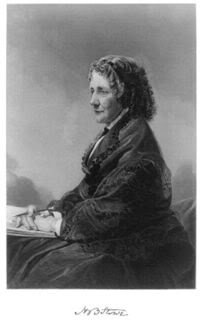
Another scandal touched the family in the 1870s when minister Henry Ward Beecher, the brother with whom Harriet had been closest, was charged with adultery with one of his parishioners, Elizabeth Tilton, who had confessed to her husband, publisher Theodore Tilton. The charges became public when Theodore Tilton told women’s rights leader Elizabeth Cady Stanton of his wife’s confession.
Image: 1872 engraving of Harriet Beecher Stowe
Based on an oil painting by Alonzo Chappel
In a well-publicized adultery trial, the jury was unable to reach a verdict. Harriet’s sister Isabella Beecher Hooker believed the charges of adultery and was ostracized by the family. Beecher’s church held a board of inquiry and exonerated Beecher, but excommunicated Mr. Tilton in 1873.
Harriet defended her brother’s innocence. In the aftermath of the trial, Harriet mostly retreated from public life and lived at her homes in the Nook Farm area of Hartford and in Florida.
After the end of the Civil War, Stowe’s brother Charles Beecher had opened a school in Florida to teach emancipated blacks, and he urged Calvin and Harriet to join him. The Stowes purchased a house and property in Mandarin, Florida, now a suburb of Jacksonville on the St. John’s River.
Harriet Beecher Stowe loved Florida, comparing its soft climate to Italy, and in 1873 she published Palmetto Leaves, describing the beauties and advantages of the state. She established a cotton plantation there and employed newly-freed slaves. Her efforts on behalf of the state and her book endeared her to Floridians.
The relatively mild winters of northern Florida were a welcome respite from Hartford winters and the high costs of winter fuel. Stowe and her family wintered in Mandarin for over 15 years in the 1870s and 1880s, until Calvin’s health prohibited long travel.
Late Years
Harriet Beecher Stowe was honored by her publisher Houghton, Mifflin and Company with a large birthday party on June 14, 1882. It was attended by over 200 guests, including many major living writers of the 19th century, including Oliver Wendell Holmes and John Greenleaf Whittier. Toasts, speeches, letters, and poems were read in honor of Stowe, her life and works.
Stowe did not appear in public much in her later years. She helped her son Charles write her biography, The Life of Harriet Beecher Stowe, which he published in 1889. She was bedridden for some years.
Calvin Stowe died in 1886.
Harriet Beecher Stowe died on July 1, 1896, at home in Hartford, Connecticut, at the age of eighty-five, surrounded by her surviving family members. She is buried in the Academy Cemetery at Andover, Massachusetts.
In all, Harriet Beecher Stowe’s writing career spanned 51 years, during which time she published more than 20 books and countless short stories, poems, articles, and hymns. Her passion for writing allowed her to publicly express her thoughts and beliefs at a time when a woman could not speak publicly, and to contribute financially to the Stowe household.
The Harriet Beecher Stowe House in Hartford, Connecticut, is the house where Stowe lived for the last 23 years of her life. It was next door to the house of fellow author Mark Twain. In the 5000 square foot cottage-style house, there are many of Stowe’s original items.
On June 13, 2007, the United States Postal Service issued a 75¢ Distinguished Americans postage stamp in her honor.
SOURCES
Harriet B. Stowe
A Little Bit of a Woman
Harriet Beecher Stowe Center
Wikipedia: Harriet Beecher Stowe
Answers.com: Harriet Beecher Stowe
Biography of the Author of Uncle Tom’s Cabin
Frederick Douglass Letter to Harriet Beecher Stowe
